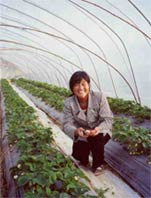
Growing interest in safer food has led to the emergence of two different organic food standards: the Green Food standard and the Organic standard. Each standard is supported by a different government agency, and reflects the interests of that agency.
As of 2000, China exports about US$15 million worth of organic foods per year, and sells about US$12.1 million domestically, according to Wenhui Daily. 110,500 acres of land is dedicated to growing organic food, producing over 100 food types: grains, vegetables, fruits, livestock and poultry, honey and seafood. Organic soybeans, rice, peanuts, tea, fruit, honey and herbal medicines are exported to the European Union. An article in People’s Daily describes a village high in the mountains that produces 60 percent of the organic tea products on the European Union market. Photo: Villager Zhou Fangrong in one of her six organic strawberry tents.
As the Chinese middle class becomes more health conscious, they are paying more attention – and money – for assurance that their food is healthy. Most are aware that the use of agricultural chemicals is poorly regulated in China, and that industrialization leaves pollutants in the soil, water and air. Many farmers located near urban areas make special arrangements with people who live in the city to produce safer products. These arrangements usually amount to simple measures to reduce contaminants. (For example, many apple growers place small bags over their apples, partly to reduce pesticide residues).
Many farmers claim to grow organic food, while freely admitting to using chemical fertilizers and pesticides on their ‘organics.’ Farmers in China’s more remote areas produce food that is organic by default, since they cannot afford synthetic inputs.
Regulatory officials are aware of the marketing potential for safer foods, and are working to establish systems for certification. They also recognize that certification could become a lucrative business for the agency that controls it, bringing a steady flow of income from certification fees. Two standards have emerged, each championed by a different agency, and each with a different emphasis, showing the agency’s interests.
The Green Food Standard
The standard that is farthest along is the Ministry of Agriculture’s (MOA) Green Food Standard, originally issued in 1992. Green Food is subdivided into two standards: A and AA. The A standard is less demanding, and appears to be directed at domestic consumers who are interested in safe food, but are not willing to pay much more to get it. The AA standard is stricter and comes closer to western notions of ‘organic food.’ It costs more, however, limiting its appeal to a smaller (but still significant) group of well-to-do citizens. As incomes grow there is likely to be a shift toward the AA standard.
Both standards rate the environmental quality of the area where the food is produced, with minimum standards for concentrations of different pollutants in the air, water and soil. The A standard bans the use of many synthetic pesticides and fertilizers, and strictly regulates the amount and timing of others. No pesticides are allowed during the period immediately prior to harvest. The AA standard prohibits the use of synthetic pesticides, hormones or veterinary medicines, and allows only simple chemical fertilizers. There are separate standards for food processing and transportation.
The China Green Food Development Center (CGFDC), the owner of the Green Food trademark, handles certification. To simplify monitoring and to keep certification costs down, the trademark is limited to larger producers and processors. The greatest advantage of this standard is its infrastructure. There are 38 certifying organizations at the provincial, county and city levels, 56 environmental monitoring organizations and 9 quality inspection organizations. The Chinese government claims to have certified 1,057 organic processing plants.
The Organic Food Standard
The chief rival to the Green Food standard is the new Organic standard, issued by the State Environmental Protection Agency (SEPA) in July, 2001. It is more strict and more closely resembles organic standards used in other countries. It forbids the use of pesticides, chemical fertilizers, hormones, additives, pigments, preservatives, and genetic engineering.
According to the USDA report this article is excerpted from, the application of this standard is challenging in China, where a large farming population and limited land makes intensive farming an absolute necessity. Under these conditions, good management can eliminate the most noxious chemicals and limit use of others, but total elimination of chemical inputs is impractical for yields to be profitable. The exception to this rule is in deep inland areas such as Inner Mongolia, but the very remoteness of these places and small scale of production makes certification difficult.
Different Priorities, Different Prospects
The Green Food Standard places it bets on the domestic market, crafting a standard that largely ignores international markets’ more stringent definitions, and focuses on food safety instead. The domestic market may well grow more quickly than export markets, however. Green Food is also ahead in terms of infrastructure, reflecting the standard’s longer history and strong contacts with producers. Green Food also provides third party audits whereas SEPA depends on the applicant’s documentation.
But SEPA’s more stringent approach may be more acceptable to export markets and its infrastructure may grow with time. Currently, the bar may be higher than most Chinese producers can meet and the costs may be too high for most middle-income consumers. (The exception to this rule may prove to be baby foods: legally mandated small families have made parents more sensitive than ever to the health needs of their children).
Excerpted from:
USDA Foreign Agricultural Service GAIN Report (Global Agriculture Information Network), #CH1072. Prepared by Ralph Bean/Xiang Qing, December 17.
[sorry this link is no longer available]
China: Dueling Standards for Organic Foods

Published on: January 8, 2002
(Visited 44 times, 15 visits today)